Tsankawi | Tsankawi Cave Dwellings | Tsankawi Petroglyphs
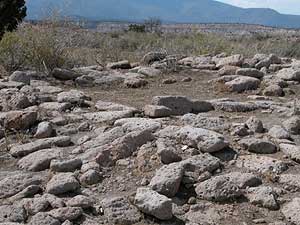
Tsankawi
We are synonymous with and born of the earth, so are we made of the same stuff as our houses....We built them, tasted them, talked with them, climbed on them, lived with them, and watched them die.... The entire community was the house.
-- Rina Sentzell, Santa Clara Pueblo write and architectural historian
Tsankawi (sank-ah-WEE) was built in the 1400s A.D. by ancient Pueblo Indians sometimes known as the Anasazi. Archeological evidence indicates that the Indians first settled the surrounding area in small communities during the late 1100s. Over time fewer, but larger communities were built. Tsankawi was one of these larger communities.
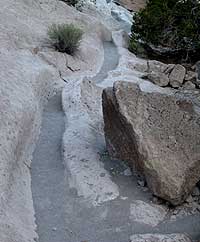 |
| Ancient trails worn into the rock. |
According to Pueblo tradition, the people of Tsankawi spoke Tewa, while those in Frijoles Canyon, the main section of Bandelier, spoke Keres. While their languages were different, their religious beliefs, lifestyles, and worldviews were similar. Even today, active pueblos San Ildefonso, Cochiti, and others retain strong social and traditional ties with these two cultural sites.
The 1.5 mile trail through Tsankawi takes you along centuries-old paths of the ancestral Pueblo people. In many areas, the trails have been worn into the rock 8 to 24 inches or more as the people traveled from the mesa tops to their farms in the canyons below. The trails also connected to other villages in the surrounding area. The natives either wore sandals or walked barefoot.
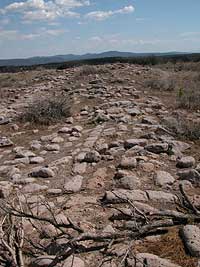 |
| Looking down one of the sides of the Tsankawi ruins. The central plaza is off to the right. |
Tsankawi Village
In the Tewa language of nearby Pueblos the name for Tsankawi, saekewikwaje onwikege, means "village between two canyons at the clump of sharp, round cacti." The village ruins are reached after the trial winds through cliffs covered with petroglyphs and climbs to the top of the Mesa. The village was built out of tuff stone plastered inside and out with mud. It was roughly rectangular in shape with about 350 rooms and an enclosed central courtyard or plaza. Not only were the rooms used for cooking and sleeping, but for storage of food for the winter months or when crops failed. The architectural design with rooms surrounding a central plaza is still used by present day Indians.The buildings were two or perhaps three stories high with roofs made out of wood and mud. But why have a village on the top of a mesa where, with the exception of rain collected into a small reservoir, water had to be hauled from the springs or rivers below? Was the mesa top a place of defense? There has not been any archeological evidence of warfare, but further research is needed.
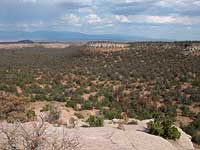 |
| Valley between mesas. |
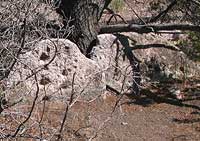 |
| Part of a wall of stones used to collect water runoff. |
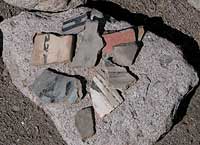 |
| Pottery shards. |
The people of Tsankawi were not isolated. There were many villages on nearby mesas or in the canyons. The people traded tools, blankets, pottery, feathers, turquoise, seashells, and agricultural products. They joined together for religious activities. The village plaza may have been a gathering place for dancing and ceremonies.
Imagine what it must have been like for the inhabitants. The mesa top would have had a flurry of activity. Women were busy cooking, sewing, grinding corn, or making pottery. Men were tending their fields in the valleys below, making tools, or tending to a number of other jobs essential for their survival. There were the sounds of children playing, people singing, dogs and turkeys chasing each other. The smells of cooking, household fires, drying meat, and people in close quarters would fill the air.
Since there was no metal, tools were made from local materials. Obsidian formed by the Jemez volcanoes was used to make arrow points, knives, and scrapers. Volcanic basalt was used as manos and metates to grind seeds and corn. It was also used to enlarge the soft tuff caves and to shape blocks used in building.
After the inhabitants left in the late 1500s, the buildings fell into ruin. The roofs collapsed and the walls crumbled. Wind blown materials filled the cracks and crevices so that only mounds of rubble can be seen with pieces of pottery lying on the ground. Today the Tsankawi mesa top is quite and peaceful, yet speaks of a people long gone.